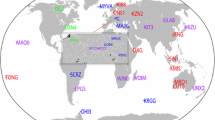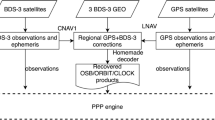Abstract
The ways of estimating the inter-system bias (ISB) have an important influence on BDS/GPS combined precise point positioning (PPP). Ordinarily, in data processing, the precise ephemeris and clock offset from the Center for Orbit Determination in Europe (CODE), Deutsches GeoForschungsZentrum (GFZ), and Wuhan University (WHU), respectively, are applied to obtain the ISB products (\({\text{ISB}}_{\text{COD}}\), \({\text{ISB}}_{\text{GFZ}}\), and \({\text{ISB}}_{\text{WHU}}\)). Currently, in the case of BDS/GPS PPP, the ISB is generally considered to be a stable value in a given day and estimated as a constant. To better understand the mechanism underlying the generation of ISB in combined PPP, we deduce and establish the ISB estimation formulas and mathematical models and collect and process data from 19 multi-GNSS experimental stations. The results show that the ranges of \({\text{ISB}}_{\text{COD}}\) and \({\text{ISB}}_{\text{WHU}}\) at different times are within 0.3 m, while \({\text{ISB}}_{\text{GFZ}}\) can change up to 6.5 m. An interesting phenomenon is that the \({\text{ISB}}_{\text{GFZ}}\) for different stations has a similar variation trend in a day, and in some days, the ISBs of all stations show a linear trend which may mainly be influenced by satellite clock offset. In addition, the temporal stability of ISB is independent of receiver software version number and antenna type, while the receiver type has little influence on the stability of ISB. Therefore, it is reasonable to estimate \({\text{ISB}}_{\text{COD}}\) and \({\text{ISB}}_{\text{WHU}}\) as constant in a day and use a random walk to obtain \({\text{ISB}}_{\text{GFZ}}\). The results show that the convergence speed and accuracy of BDS/GPS PPP obtained by the random walk method are higher than those using the constant method, no matter whether \({\text{ISB}}_{\text{GFZ}}\), \({\text{ISB}}_{\text{COD}}\), or \({\text{ISB}}_{\text{WHU}}\) is used.












Similar content being viewed by others
References
Blewitt G (1990) An automatic editing algorithm for GPS data. Geophys Res Lett 17(3):199–202
Chen J, Xiao P, Zhang Y, Wu B (2013). GPS/GLONASS system bias estimation and application in GPS/GLONASS combined positioning. In: China Satellite navigation conference (CSNC), 2013 Proceedings, pp 323–333
Chen J, Zhang Y, Wang J, Yang S, Dong D, Wang J, Qu W, Wu B (2015) A simplified and unified model of multi-GNSS point positioning. Adv Space Res 55(1):125–134
Chen J, Wang J, Zhang Y, Yang S, Chen Q, Gong X (2016) Modeling and assessment of GPS/BDS combined precise point positioning. Sensors 16(7):1151
Defraigne P, Aerts W, Harmegnies A, Petit G, Rovera D, Uhrich P (2013) Advances in multi-GNSS time transfer. European frequency and time forum and international frequency control symposium. IEEE 2013:508–512
Geng J, Guo J, Chang H, Li X (2018) Toward global instantaneous decimeter-level positioning using tightly coupled multi-constellation and multi-frequency GNSS. J Geod 93(2):1–15
ICD-GPS-200C (2000.04) Interface control document-navstar GPS space segment/navigation user interface. http://www.gps.gov/technical/icwg/. Accessed Apr 2000
Jiang N, Xu Y, Xu T, Xu G, Sun Z, Schuh H (2015) GPS/BDS short-term ISB modelling and prediction. GPS Solut 21(1):1–13
Khodabandeh A, Teunissen PJG (2016) PPP–RTK and inter-system biases: the ISB look-up table as a means to support multi-system PPP–RTK. J Geod 90(9):837–851
Li P, Zhang X (2014) Integrating GPS and GLONASS to accelerate convergence and initialization times of precise point positioning. GPS Solut 18(3):461–471
Li X, Ge M, Dai X, Ren X, Fritsche M, Wickert J, Schuh H (2015a) Accuracy and reliability of multi-GNSS real-time precise positioning: GPS, GLONASS, BeiDou, and Galileo. J Geod 89(6):607–635
Li X, Zus F, Lu C, Dick G, Ning T, Ge M, Wickert J, Schuh H (2015b) Retrieving of atmospheric parameters from multi-GNSS in real time: validation with water vapor radiometer and numerical weather model. J Geophys Res: Atmos 120(14):7189–7204
Li X, Li X, Yuan Y, Zhang K, Zhang X, Wickert J (2018) Multi-GNSS phase delay estimation and PPP ambiguity resolution: GPS, BDS, GLONASS, Galileo. J Geod 92(6):579–608
Liu J, Ge M (2003) PANDA software and its preliminary result of positioning and orbit determination. Wuhan Univ J Nat Sci 8(2):603
Liu T, Yuan Y, Zhang B, Wang N, Tan B, Chen Y (2016a) Multi-GNSS precise point positioning (MGPPP) using raw observations. J Geod 91(3):251–268
Liu Y, Ye S, Song W, Lou Y, Chen D (2016b) Integrating GPS and BDS to shorten the initialization time for ambiguity-fixed PPP. GPS Solut 21(2):333–343
Lou Y, Zheng F, Gu S, Wang C, Guo H, Feng Y (2016) Multi-GNSS precise point positioning with raw single-frequency and dual-frequency measurement models. GPS Solut 20(4):849–862
Malys S, Jensen PA (1990) Geodetic point positioning with GPS carrier beat phase data from the CASA UNO experiment. Geophys Res Lett 17(5):651–654
Mi X, Zhang B, Yuan Y (2019) Multi-GNSS inter-system biases: estimability analysis and impact on RTK positioning. GPS Solut. https://doi.org/10.1007/s10291-019-0873-8
Nadarajah N, Teunissen P, Raziq N (2013) BeiDou inter-satellite-type bias evaluation and calibration for mixed receiver attitude determination. Sensors 13(7):9435–9463
Odijk D, Teunissen PJG (2013) Characterization of between-receiver GPS-Galileo inter-system biases and their effect on mixed ambiguity resolution. GPS Solut 17(4):521–533
Paziewski J, Wielgosz P (2015) Accounting for Galileo–GPS inter-system biases in precise satellite positioning. J Geod 89(1):81–93
Shi C, Yi W, Song W, Lou Y, Yao Y, Zhang R (2013) GLONASS pseudorange inter-channel biases and their effects on combined GPS/GLONASS precise point positioning. GPS Solut 17(4):439–451
Torre AD, Caporali A (2015) An analysis of inter-system biases for multi-GNSS positioning. GPS Solut 19(2):297–307
Wanninger L (2012) Carrier-phase inter-frequency biases of GLONASS receivers. J Geod 86(2):139–148
Zeng A, Yang Y, Ming F, Jing Y (2017) BDS–GPS inter-system bias of code observation and its preliminary analysis. GPS Solut 21(4):1573–1581
Zhou F, Dong D, Li P, Li X, Schuh H (2019) Influence of stochastic modeling for inter-system biases on multi-GNSS undifferenced and uncombined precise point positioning. GPS Solut. https://doi.org/10.1007/s10291-019-0852-0
Zumberge JF, Heflin MB, Jefferson DC, Watkins MM, Webb FH (1997) Precise point positioning for the efficient and robust analysis of GPS data from large networks. J Geophys Res Solid Earth 102(B3):5005–5017
Acknowledgements
The contribution of data from MGEX is appreciated. This research is supported by the Major Project of Beijing Future Urban Design Innovation Center, Beijing University of Civil Engineering and Architecture (UDC 2018031321), the National Science Foundation for Distinguished Young Scholars of China (Grant No. 41525014), the Natural Science Innovation Group Foundation of China (No. 41721003), the Major Technology Innovation Project of Hubei Province of China (2018AAA066), the Youth Fund of the National Natural Science Fund project (41704030), and the National Key Research and Development Program of China (2018YFC1503600).
Author information
Authors and Affiliations
Corresponding author
Additional information
Publisher's Note
Springer Nature remains neutral with regard to jurisdictional claims in published maps and institutional affiliations.
Rights and permissions
About this article
Cite this article
Liu, X., Jiang, W., Chen, H. et al. An analysis of inter-system biases in BDS/GPS precise point positioning. GPS Solut 23, 116 (2019). https://doi.org/10.1007/s10291-019-0906-3
Received:
Accepted:
Published:
DOI: https://doi.org/10.1007/s10291-019-0906-3




